Report
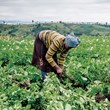
This article is Chapter 2 of Bain’s report on Africa’s critical agricultural intermediaries. Explore the contents of the report here or download the PDF to read the full report.
In this chapter, we profile three models of farmer-allied intermediaries anchoring local value chain development (see Figure 1). Two of the three, Dodla Dairy and Babban Gona, intentionally put smallholder farmers at their center, and by doing so, they illustrate how that focus can expand the impact of an intermediary in critical ways. The third, Twiga Foods, is different. Though smallholder farmer allied today, that is more a function of available supply than a purposeful choice. As a result, as it has grown, Twiga has begun to shift to working with larger farms to achieve its company mission of reducing the cost of food for urban consumers.
Three successful farmer-allied intermediaries

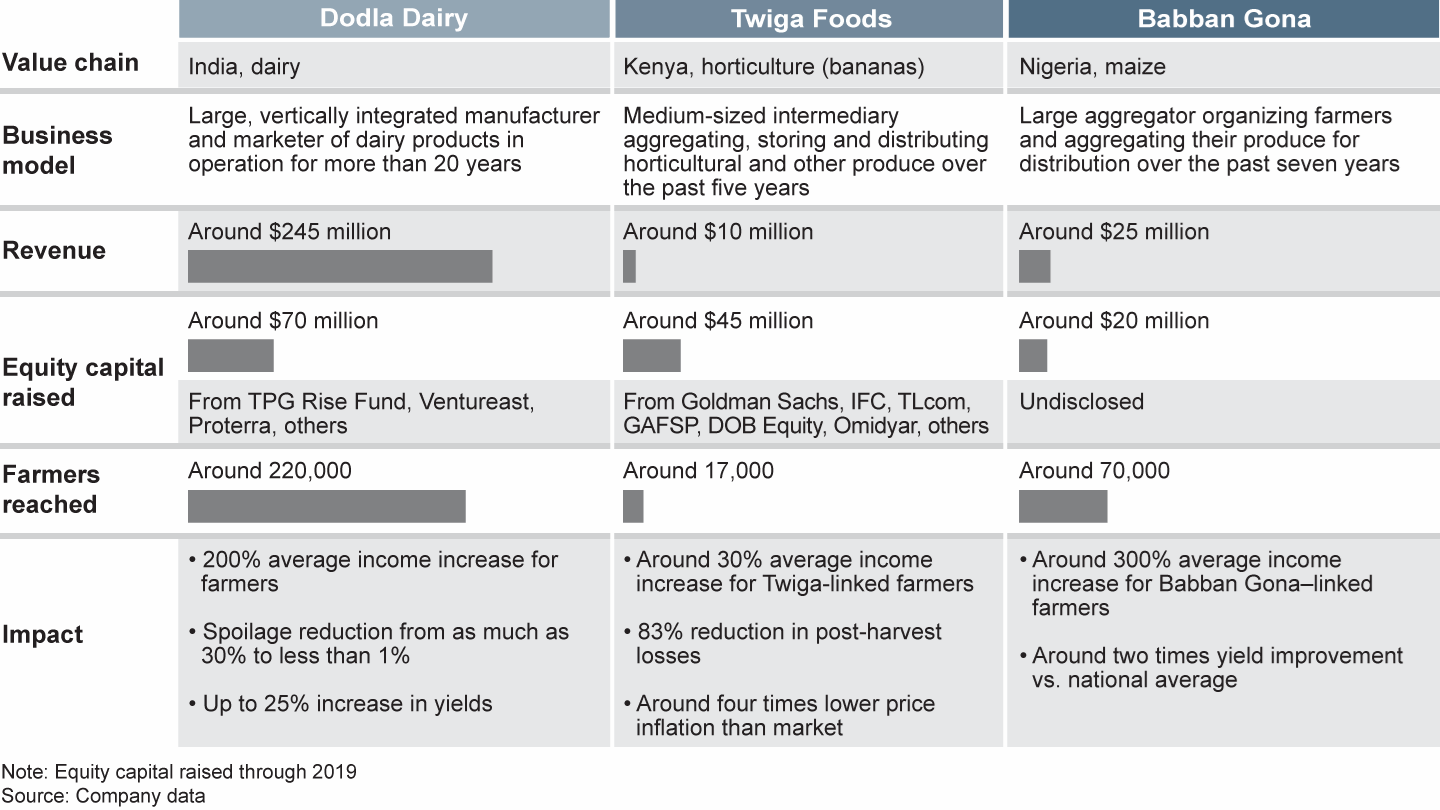
Together, these stories illustrate that farmer-allied enterprises with well-defined, repeatable models can succeed in different value chains and contexts.
Each will show a specific value chain and how that context determines the potential margin of enterprises operating within it; the distinctive, repeatable business model designed by the entrepreneur, including the degree of vertical integration, key operational choices and how it engages with farmers; the importance of intention—namely, whether an intermediary’s farmer-allied behavior and investments are likely to persist and have sustained impact on smallholder farmers; lessons learned and implications for others connected to this value chain.
Dairy: The power of comprehensive sector development in India
When it comes to agricultural value chains that can simultaneously deliver on multiple development goals, few rival dairy, which improves farmer livelihoods, creates jobs, supports agricultural industrialization and commercialization, and enhances nutrition.
Key characteristics of the dairy value chain:
- Smallholder farmers supply the vast majority of milk production in India. Many farmers own a few head of dairy cattle that can be milked twice a day, making it possible to generate relatively frequent cash flow.
- Milk can be processed into a range of high-value-added products. Beyond fresh pasteurized milk, there’s ultra-high-temperature pasteurized milk that has a longer shelf life, yogurt, ice cream, butter and cheese. All have the potential for higher margins and opportunity to add value through processing. Demand for these products tends to increase with higher incomes and urbanization.
- High perishability raises the importance and value of quality control, making it well suited to a vertically integrated model with direct farmer engagement.
- Dairy consumption is one of the most efficient and effective ways to address malnutrition, especially for children younger than five. Pasteurized milk, in particular, is safer to consume than raw milk.
The best-developed dairy value chain based on smallholder farmers is in India, where 70% of milk is produced by smallholder farmers and 85% of all dairy farmers own herds of fewer than 10 animals. Dairy accounts for approximately one-third of rural household income in India. Over the past two decades, animal productivity has nearly doubled, and national milk production has grown to more than 180 million tons. A key factor has been the proliferation of private dairy enterprises that now account for more than 60% of dairy processing capacity in the country. Many now are publicly listed.
The development of India’s dairy sector is more than four decades in the making. Between 1970 and 1996, the government systematically developed the dairy industry through a program called “Operation Flood.” It began by linking supply from milksheds—that is, geographical areas producing milk—to their appropriate end markets. Once supply and demand were connected, phase two focused on organizing farmers, setting up farmer cooperatives and extending the milkshed network. In the mid-1980s, the government began the next phase, providing extension services and continuing to extend credit to cooperatives.
This phased approach created the conditions that made it possible for farmer-allied intermediaries to thrive. Since the beginning of Operation Flood, the dairy sector has had priority lending status, a critical support. Starting in 1985, the Reserve Bank of India (RBI) required that 18% of Indian commercial lenders’ adjusted net bank credit (ANBC) be extended to agriculture. In the 1990s, when many of India’s dairies began to privatize, the government further encouraged commercial banks to lend to agriculture and permitted private and foreign direct investment in the sector. Today, government policy continues to support smallholder farmers and those that buy from them. In 2015, the RBI declared that lending to small and marginal farmers—that is, those with plot sizes of less than two hectares—must account for 8% of ANBC, though lenders have yet to reach that target.
Against this backdrop of broad government support for smallholder farmers and allied intermediaries, dozens of private dairies have emerged. One of the biggest entrepreneurial success stories is Dodla Dairy, which sources from more than 220,000 smallholder farms. Founded in 1995, based in Hyderabad and with $245 million in revenue in 2018, Dodla has built itself into an efficient, vertically integrated processor and marketer of a variety of quality dairy products over the past 25 years. It has raised at least $150 million in capital, including $50 million in equity recently invested by TPG’s Rise Fund and $76 million in debt, including $15 million from the International Finance Corporation and some limited grants. After first establishing its repeatable model in Andhra Pradesh, it has since expanded to the southern Indian states of Telangana, Tamil Nadu and Karnataka, and it has begun to replicate its model in Uganda.
What makes Dodla work?
First, its vertically integrated model ensures quality in a highly perishable product and helps Dodla create value-added products with higher margins, such as ice cream. Given that the supply of milk overwhelmingly comes from smallholder farmers, the company realized early on that farmers’ success would fuel Dodla’s growth. The company supports farmers by subsidizing their access to high-quality agricultural inputs, including cattle feed, and services, such as veterinary support and selective breeding, and by linking farmers in need of financing to collaborating banks. Dodla pays fair market prices regularly every 11 days based on quality, and as a result, it has a secure and steady supply of quality milk (see Figure 2). Loyal farmers increase their income and cash flow, and Dodla gets better quality, greater quantity and a more reliable supply. Over the past decade, competition has grown for these farmers’ milk, so in order to remain a compelling partner, Dodla has had to find new ways to help farmers grow their dairy income. Today, farmers supplying Dodla earn more than 2 times what the average Indian smallholder farmer does, with yields that are up to 25% higher than the national crossbred average.
The Dodla Dairy model of farmer-allied intermediary

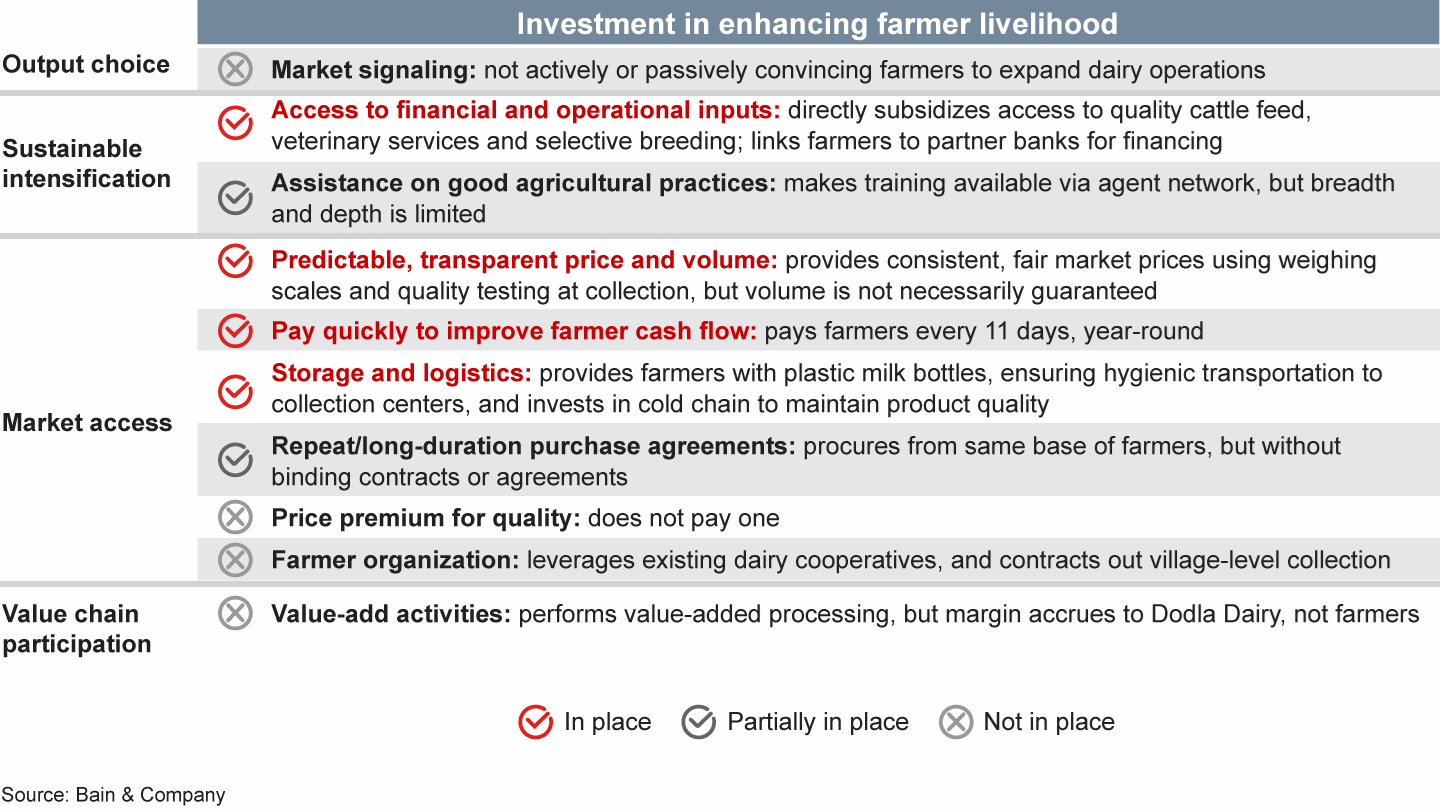
Second, it has a highly efficient and scalable capillary sourcing model that includes more than 5,000 collection centers, 85 centralized chilling centers and 13 processing plants. Nearly half of the collection centers are run by agents that bear the responsibility for collecting the milk from farmers and delivering it to chilling centers. Each processing plant is supplied by a network of 450 collection centers, from which milk is transported in less than four hours to one of six chilling centers (see Figure 3). At the chilling centers, automated milk analyzers assess the quantity and quality of the milk before it is shipped to the processing plant, which is two hours away. This end-to-end quality control results in more milk making it to processing plants in good condition, helping to ensure that consumers get high-quality products that command premium prices. Dodla’s tech-enabled processing of milk into dairy products increases operational efficiency by reducing waste and maintaining uniform quality across products. As a result of Dodla’s highly efficient model, spoilage rates for Dodla farmers are less than 1% year round, much lower than the national average, which can reach 30% during the hot season.
Dodla Dairy’s model has strong value for farmers, efficient aggregation and processing, and quality preservation

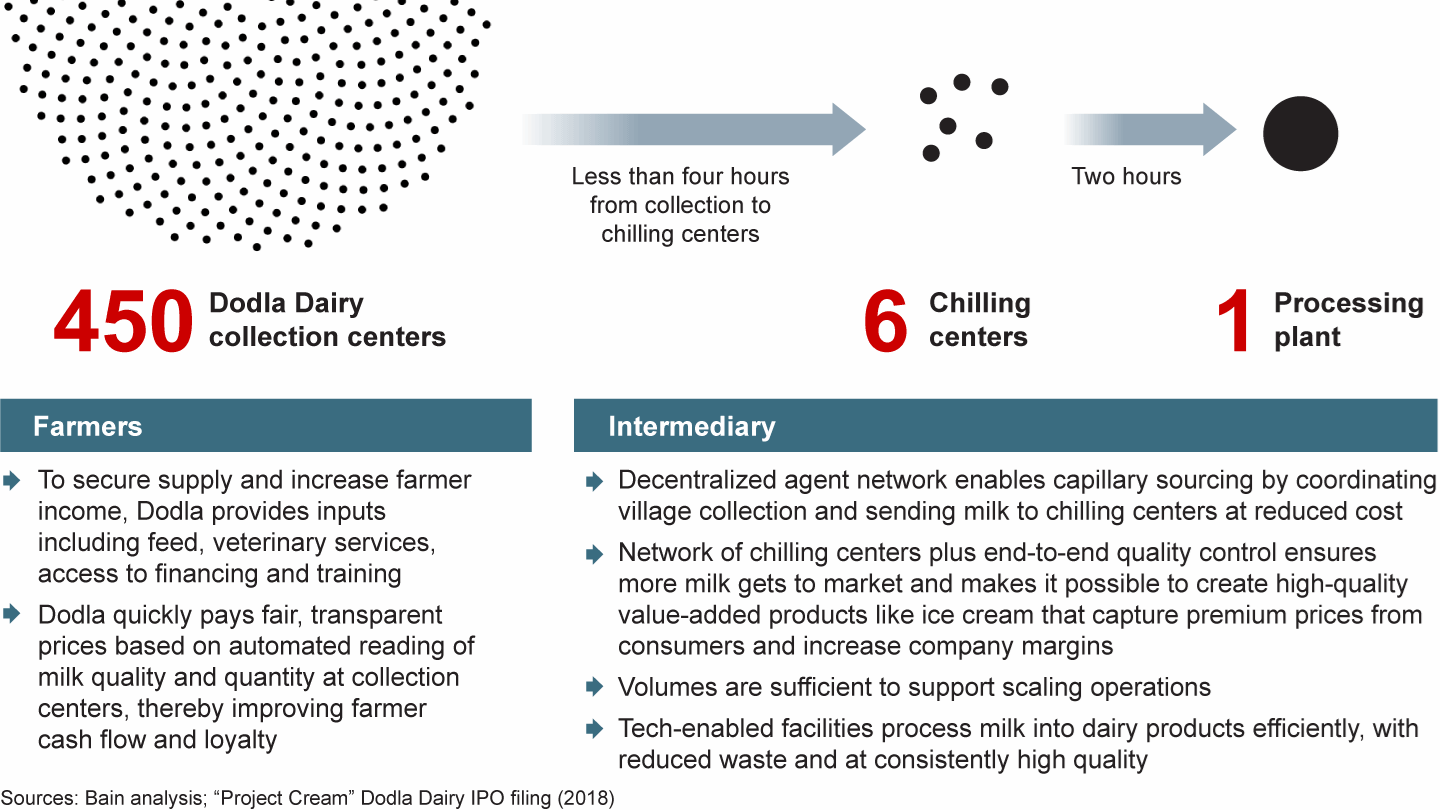
Key insights:
- Government intervention is vital to creating the necessary conditions for private enterprises to thrive, and it can be highly effective when planned with a long-term, full-system approach. In this case, the development of the dairy sector was spurred by a phased, multipronged approach that included tax incentives, food quality standards, subsidies on inputs, infrastructure provisions such as cold chain and electrification, and regulations that a percentage of loans be made in the rural economy.
- Given the nature of the dairy value chain, vertically integrated companies can play a critical role in economic development by creating jobs and enhancing farmer livelihoods as well as by improving nutrition for a growing, increasingly urban population.
- For highly perishable crops such as dairy, capillary sourcing and vertical integration ensure product quality and premium prices. Vertical integration enables margins high enough to support investment in farmers while also delivering market or near-market rates of return, assuming system conditions are in place that allow enterprises to scale profitably.
- Intermediaries must be highly engaged with smallholder farmers if they wish to secure their trust, reduce side selling and assure product quality. Building trust and loyalty is critical to securing supply because milk can be consumed on the farm and can be sold to neighbors, traders and local markets. Consistency in payment, provision of quality services and inputs, and ongoing engagement combine to win farmers’ hearts and output.
- When a large amount of capital is required for extensive processing, a strong ability to fund growth through retained earnings and commercial or return-oriented capital (both debt and equity) is crucial.
Fresh fruits and vegetables: The promise of tech-enabled aggregation in Kenya
While India’s dairy success story has been decades in the making, a technology-based intermediary model has more recently begun to disrupt Kenya’s fresh fruit and vegetable supply chain.
As more people move to urban centers and incomes increase, demand for fresh fruits and vegetables has grown in Kenya’s cities. At the start of the century, 80% of Kenyans lived in rural areas, and GDP per capita was $820. By 2017, Kenya’s population had grown by more than 50%, to 50 million, and today, more than a quarter of them live in a city. Real GDP per capita increased more than 40% during this period, to $1,157. Today’s urban Kenyans spend 3 times what their rural counterparts do on fresh produce.
Through all this change, the retailing of food in Kenya has remained the same—that is, highly fragmented and largely informal. There are 180,000 small food vendors in Nairobi alone. Across the country, 90% of food is sold through small roadside stands and other informal channels.
Rising demand and expendable income combined with fragmented distribution, high rates of post-harvest loss and expensive logistics have fueled food price increases far beyond the rate of inflation. Today, as much as 45% of Kenyan disposable household income is spent on food.
Kenya is one of the most digitally enabled countries in sub-Saharan Africa: 3G cellular covers 93% of the population, and the price of mobile data has steadily decreased.
Also, the use of mobile payments is widespread: More than 70% of people have a mobile money account.
There is a big opportunity for ag tech in Kenya. Ag tech encompasses a range of tech-enabled solutions for agriculture—from robotics and hydroponics to new types of credit scoring that expand financing options for unbanked farmers and mobile advisory services and platforms that connect farmers to input providers and sellers. Bain research has shown that investment in ag tech, which is growing 16% per year across sub-Saharan Africa, is climbing especially fast in Kenya: 57% annually. Agricultural impact investment is an important part of that: 10% of impact investment in the region goes to ag tech, of which 60% is made in Kenya.
Recognizing a unique opportunity, Grant Brooke, a food economist, and Peter Njonjo, a Coca-Cola executive, founded Twiga Foods in 2014 as an aggregator aimed at making fruits and vegetables more affordable and available to the low-income urban consumer. In the years since its founding, Twiga has become an important partner to thousands of smallholder farmers, the source of its bananas. But Twiga’s mission is to serve urban consumers. As a result, its engagement with smallholder farmers has been a by-product of its business model, not a central pillar of it, and as it expands and raises commercial capital, Twiga has started buying more from larger commercial farms to reduce costs. Farmer allied during its early growth phase, it’s unclear whether Twiga will continue to fit this category in the future.
When it launched, Twiga conducted trials with different crops before settling on bananas. Bananas represented a commodity moving in large volumes from farm to market that could benefit from Twiga’s mobile and digital technology that matches fragmented supply to broad demand. Bananas are well suited to Twiga’s approach to actively managing post-harvest loss, are a good source of nutrition as one of the fruits with the highest caloric value per shilling and are in large perennial supply, ripening throughout the year. Smallholder farmers, who are unlikely to switch crops because a tree takes nine months to mature, serve as a secure base of suppliers. Despite its popularity in Kenya, the banana does not carry a high margin or significant processing value, and because it’s highly perishable, it must be carefully handled, chemically treated and moved quickly. Similar to other produce in Kenya, bananas are sold primarily through little kiosks run by women vendors known as “mama mbogas” and small family-run shops called “dukas.”
The crop requires a capillary sourcing model, similar to the Indian dairy market, as well as a capillary distribution model. With its digitally enabled business model, Twiga has been able to reduce unit costs, achieving positive unit economics in just a few years despite relatively low margin potential. All of which has made it appealing to investors, and it has attracted commercial capital early. Since establishing its repeatable model in bananas, Twiga has replicated something similar for other commodities, including potatoes, tomatoes, onions and watermelons.
What makes Twiga work?
Broadly, Twiga’s repeatable model has three key elements.
- Focus on high-velocity/high-demand products. Quick turnover allows for faster working-capital cycles as well as more data collected from farmers and vendors that can be used to better price the risk of lending to farmers and vendors.
- Actively manage post-harvest losses. Highly perishable items are at increased risk of waste, and that increases the upside when post-harvest losses are well managed.
- Use technology to make the value chain efficient. Twiga matches fragmented suppliers (farmers) with fragmented buyers (urban vendors) and efficiently manages product flow and inventory.
Here is how it works: Farmers bring their harvest to one of 16 collection centers, where prices are posted daily. Because they do not have to pick up from farmers, Twiga is able to keep its logistics costs low. From the collection centers, the fruit moves to Twiga’s warehouse, where it is stored, ripened, sorted and graded into stockkeeping units. It is then packed into standardized crates that make handling more efficient and sent to 18 different distribution depots selling to 7,800 vendors in Nairobi (see Figure 4). This high-velocity, centralized process significantly reduces waste and spoilage, and it cost-effectively moves more produce to market, providing vendors with a secure supply of produce from fragmented suppliers in remote regions, direct delivery and fair prices.
Twiga has created a technologically advanced end-to-end logistics system valuable to farmers and vendors


Underpinning Twiga’s end-to-end logistics system is a technology platform that transparently and efficiently matches supply and demand. The aggregator prebooks orders and then pays smallholder farmers within 24 hours, year-round, using M-Pesa, a ubiquitous mobile money payments system. Twiga offers its transparent and predictable pricing to more than 17,000 smallholder farmers. Its platform enables a cashless purchase process and provides a digital transaction history that can be used to help vendors access financial services, including working-capital loans from financial service providers that partner with Twiga.
By consolidating activities traditionally split between traders buying from farmers and wholesalers selling to vendors, Twiga has benefited smallholder farmers and increased urban consumers’ access to quality, affordable products (see Figure 5).
The Twiga model of farmer-allied intermediary

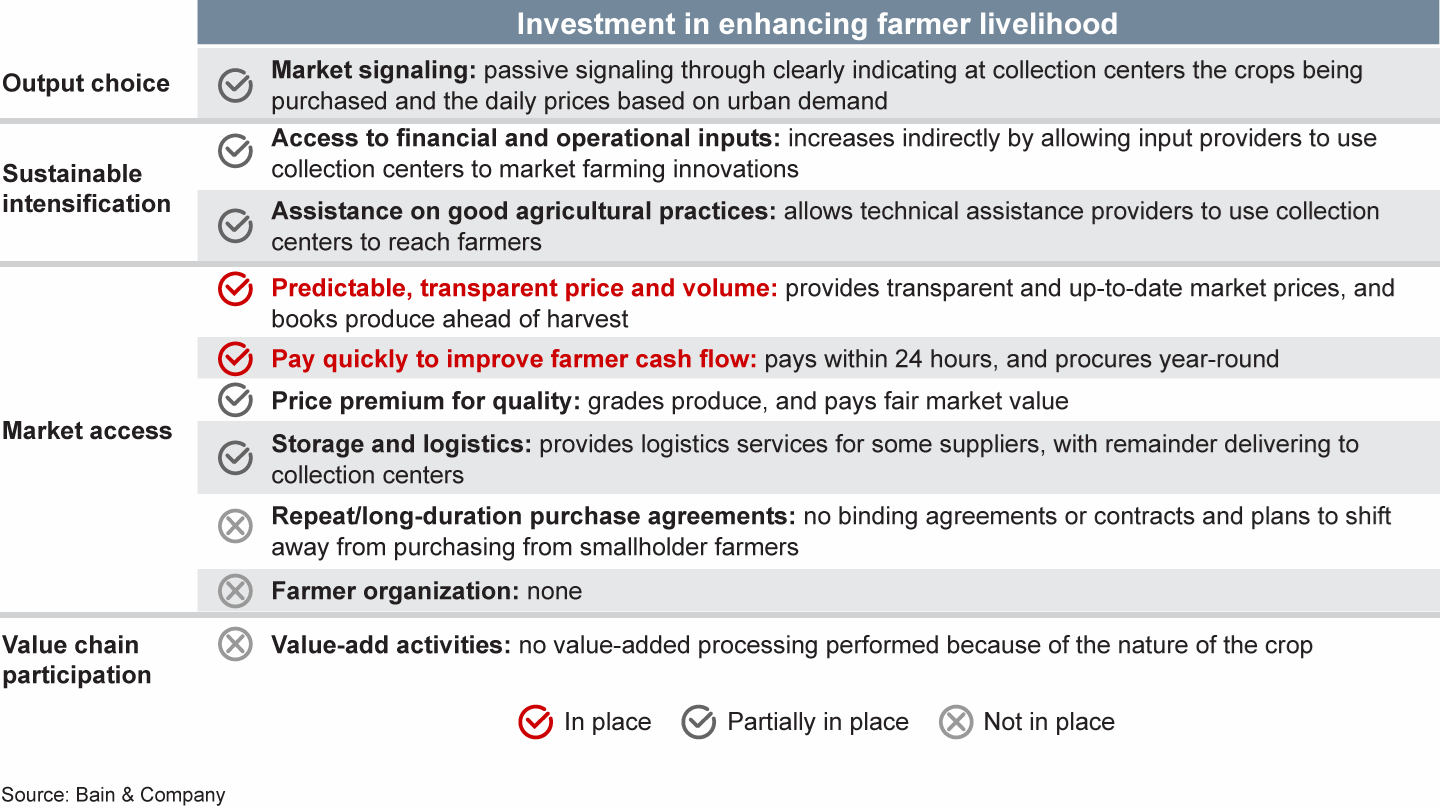
Twiga has attracted significant commercial backing—more than $65 million as of the end of 2019—but this success illuminates a tension between farmer inclusivity and financial returns. According to Twiga management, it costs approximately 40% less to source from a medium-scale commercial farmer than it does from a smallholder farmer. To meet investors’ return expectations and deliver on its original mission of making sufficient quantities of fresh fruits and vegetables of consistent quality more affordable to urban consumers, Twiga now buys more from medium- and large-scale farmers and less from smallholder farmers. While increasing the benefits it can offer consumers, this shift away from smallholder farmers means at least some of those farmers will likely have to return to selling to traders. Twiga is now developing a marketplace to help these traders become agents and better aggregate smallholder farmer output.
Clearly, there are real trade-offs between financial returns and smallholder farmer inclusivity, and farmer-allied behaviors cannot be taken for granted. Intermediary intention is critical to not only attaining but also sustaining some of the long-term economic benefits a farmer-allied intermediary model can bring.
A second model
The experience of another Kenyan aggregator, Tulaa, illustrates how an innovative model designed to serve smallholder farmers can follow a different growth trajectory. Similar to Twiga, Tulaa focuses on horticultural products from smallholder farmers—primarily potatoes, cabbage, watermelon and onions— and uses a digital platform to aggregate supply and match it with demand. One difference is that Tulaa focuses on bulk sales to wholesalers in the urban markets of Nairobi and Mombasa; another difference is the kind of capital it must attract.
While Twiga’s mission is focused on meeting urban consumer demand, Tulaa was set up expressly to serve smallholder farmers and help them access the market. Initially in partnership with financial institutions, eventually lending on its own, Tulaa’s original offering was microfinancing to farmers. Over time, it has added many other supports, including tailored input packages available on credit through rural retailers; agricultural advice delivered to farmers over SMS; a call center staffed with agronomists to answer farmer questions; logistics support, including crop collection at the farm gate; and a digital platform that enables traceability of product to farmer as well as quality guarantees and auditable payment history. All of these supports help farmers enjoy the economic benefits of an improved supply chain (see Figure 6).
The Tulaa model of farmer-allied intermediary

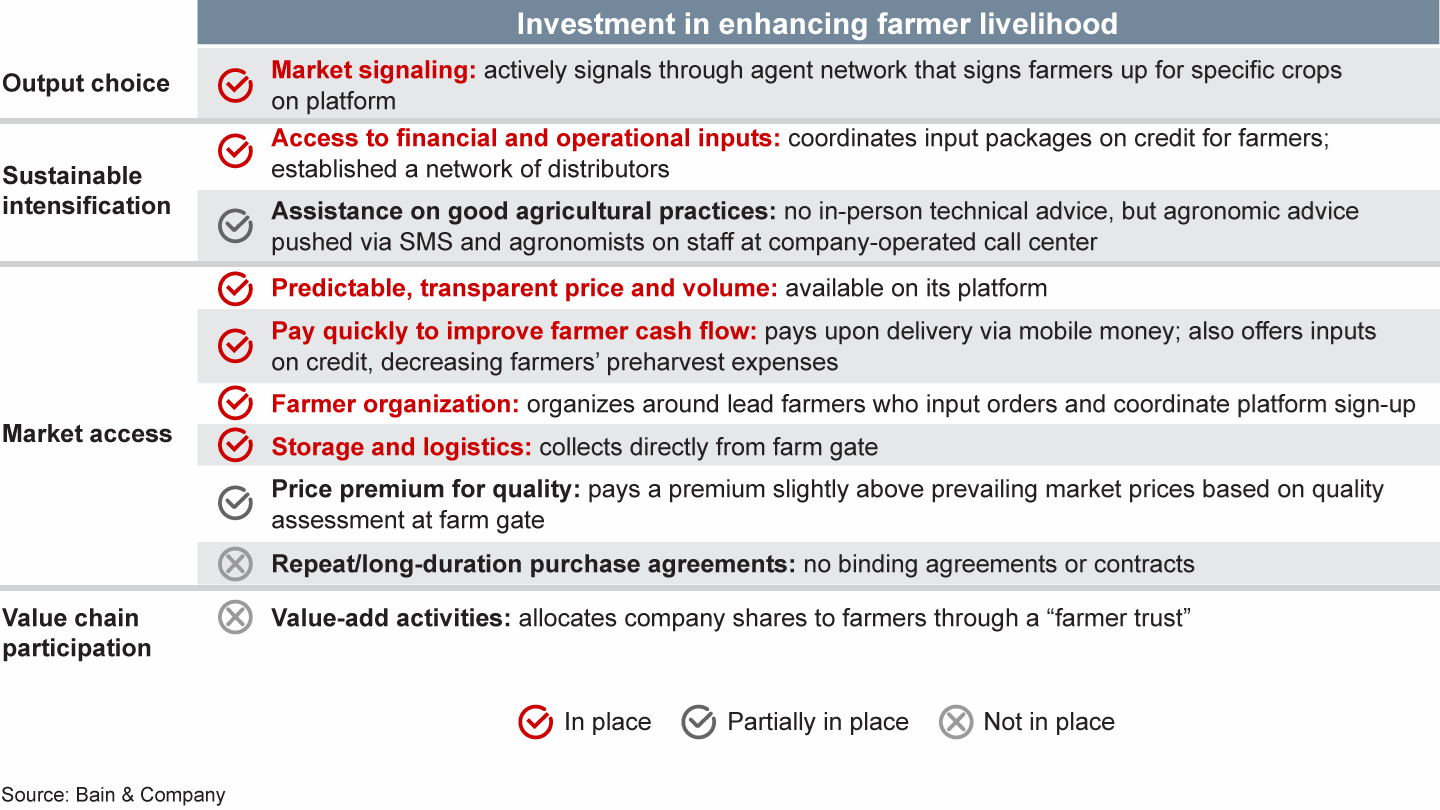
At Tulaa’s core is a digital platform with transparent price and volume data, supplemented with a significant on-the-ground analog integration of farmers into the supply chain. A network of lead farmers called “agents” communicate which crops are in demand, sign up smallholder farmers and accept credit applications. These agents collect from the farm gate and conduct quality assessment to determine whether farmers should be paid a slight premium. Tulaa hopes that by helping its smallholder farmers fully integrate into formal supply chains, they will enjoy higher, more reliable incomes over the long term.
Though helpful to farmers, all these services add to the cost of doing business, extending the time it takes for the company to reach positive unit economics. Early-stage, tech-enabled models allied with smallholder farmers, such as Tulaa’s, are unlikely to yield the kind of financial returns investors have come to expect from proven fintech models in other fields. For this reason, Tulaa has rightly relied on patient capital investors and grants that allow the company to keep investing in its farmer-allied practices. To meet its goal of breaking even by 2021, Tulaa will have to increase revenue tenfold and will require continued fund-raising.
Key insights:
- Horticulture value chains have high potential in countries with solid food security (including access to affordable caloric staples) and growing urban demand for fresh fruits and vegetables, though more efficient and effective aggregation and connection of farmer supply to retailer demand are required.
- A tech-enabled aggregator can achieve positive unit economics and attract more commercial capital, even at an early stage, by focusing on specific high-volume, high-velocity value chains; closely managing post-harvest losses; and leveraging technology to reduce unit costs.
- Technology can match fragmented suppliers (farmers) with fragmented buyers (urban vendors) and efficiently manage product flows and inventory as the intermediary scales.
- Quick turnover of product allows faster working-capital cycles and collection of more data from farmers and vendors—data that can be used to establish trading histories and thereby better assess and price the risks of lending.
- Highly perishable items have a high risk of waste, but also increased upside if post-harvest losses are well managed. Reducing post-harvest losses, about 30% of the price of bananas, was a big opportunity in Kenya.
- Entrepreneur intent dictates the scope, depth and duration of investment in smallholder farmers, and that, in turn, affects the profitability of the intermediary business.
- Models that are highly focused on smallholder farmers and that address a full range of value chain bottlenecks will be less profitable than firms operating in the same value chain that are not explicitly farmer-allied.
- Intermediaries that are intentionally allied with smallholder farmers are likely to require far greater amounts of philanthropy and impact-oriented patient capital, especially in their early stages.
Cereals: Solving the “staple crop conundrum” in Nigeria by selling to local anchor buyers
Cereals such as maize, sorghum and millet represent nearly half of the calories consumed in sub-Saharan Africa each day. Of the local cereals, maize is the most popular in eastern and southern Africa, accounting for nearly 50% of calories consumed in those regions and approximately 20% in western Africa. In the top producing countries, smallholder farmers grow approximately 80% of the maize crop, but they are doing so inefficiently. The gap between yields in sub-Saharan Africa and the global average has steadily increased over the years, and today, the region’s output is 2.7 times lower than global levels of productivity. This is one reason why from 1970 to 2010, as the region’s population grew, cereal imports to sub-Saharan Africa also increased 5% per annum.
Cereal value chains, such as that of maize in Nigeria, have long presented a conundrum to entrepreneurs and investors. Compared with other crops, staples have lower margin potential. The biological and economic characteristics of their value chains make it challenging to build profitable, scaled, farmer-allied intermediaries. For example, infrequent harvests (one to two per year) mean farmers do not have regular cash flow with which to buy inputs. Staples can be consumed with minimal processing, further limiting margin upside. Farmers are prone to side selling as well, so securing a sufficient quantity of produce for processing is a big challenge for intermediaries in a value chain that relies on scale to achieve profitability. To ensure high-quality cereal, intermediaries often must buy and keep this inventory since smallholder farmers seldom have the infrastructure to properly store crops. That adds to costs and cuts into profits as well.
Recently, a few promising intermediary models have emerged in cereals, and they have some common characteristics:
- A large, secured source of demand from a reliable buyer that uses the crop in a high-value consumer good and that is willing to pay a premium price for a reliable supply of quality produce;
- High farmer engagement that builds loyalty and improves farmer productivity and crop quality;
- Innovation that enables efficiency, reduces post-harvest loss and improves quality;
- Ruthless efficiency in aggregation and transportation; and
- Vertical integration to maximize margin.
In 2012, a start-up Nigerian aggregator, Babban Gona, pioneered a model that exemplifies many elements of this approach. In Nigeria, smallholders account for more than 70% of maize production, and many factors contribute to low productivity, including poor-quality inputs such as seeds and fertilizers, humid storage conditions, and breakage during manual deshelling, cleaning and sorting. In all, 15% to 20% of production is lost. Of what’s left, half ends up in animal feed, and only 15% meets the quality standards required for consumer packaged goods such as cereals, baby food and beer. Combined with drought, this high rate of crop loss and low quality has left Nigeria with one of the highest maize prices in sub-Saharan Africa.
Three critical elements of Babban Gona’s approach have helped it address these long-standing issues.
First, it successfully captures a premium price for providing a reliable supply of quality maize to large buyers, including Nestlé, which uses it in cereal sold in Nigeria. It has done this in part by helping nearly 70,000 smallholder farmers improve their crops and increase their average yield, now double the national average. Babban Gona also stores and holds maize to sell later, when it is in shorter supply and prices are higher. The company shares the profit from this arbitrage with farmers, resulting in a premium over the average price farmers get from traditional traders at the farm gate. As a result, the average annual net income per hectare of farmers working with Babban Gona has nearly tripled.
Second, by allying directly with them and bringing such clear financial benefit, Babban Gona has convinced farmers to abandon traditional sales channels and to significantly decrease side selling. The company works closely with farmers who join its co-op, coordinating packages of inputs that they can purchase on credit and offering connections to providers of equipment that individual farmers may not be able to purchase (including tractors). Through a group of local co-op leaders, Babban Gona offers training to farmers, and its agents make field visits, helping to ensure best-practice farming methods are followed in its dispersed smallholder network. Once the maize is produced, Babban Gona purchases each farm’s output at market price, transports the crop from the farm gate, and passes back to farmers any premium realized on sales to Nestlé or other buyers.
Babban Gona makes a series of staggered payments to farmers throughout the year. This includes pre-harvest loans in the form of in-kind inputs, payment upon deposit of the grains with Babban Gona and bonuses for premium-priced cereal. Farmers enjoy a larger and more regular flow of cash, contributing to their loyalty to the company and encouraging them to keep selling to Babban Gona.
The third critical element of Babban Gona’s business model is how it minimizes post-harvest loss and maximizes efficiency. Its more than 50 geographically dispersed collection centers have the capacity to store 150 metric tons of crop in optimal conditions. Each center gathers the output of roughly 200 local cooperatives—the company calls them “trust groups”—that coordinate distribution, quality inspection and the mechanized deshelling of 800 smallholder farmers’ yearly harvests. The company’s high-quality storage minimizes the development of aflatoxins produced by fungi on maize and other crops and, as noted, makes it possible to sell when prices are higher (see Figures 7 and 8).
The Babban Gona model of farmer-allied intermediary

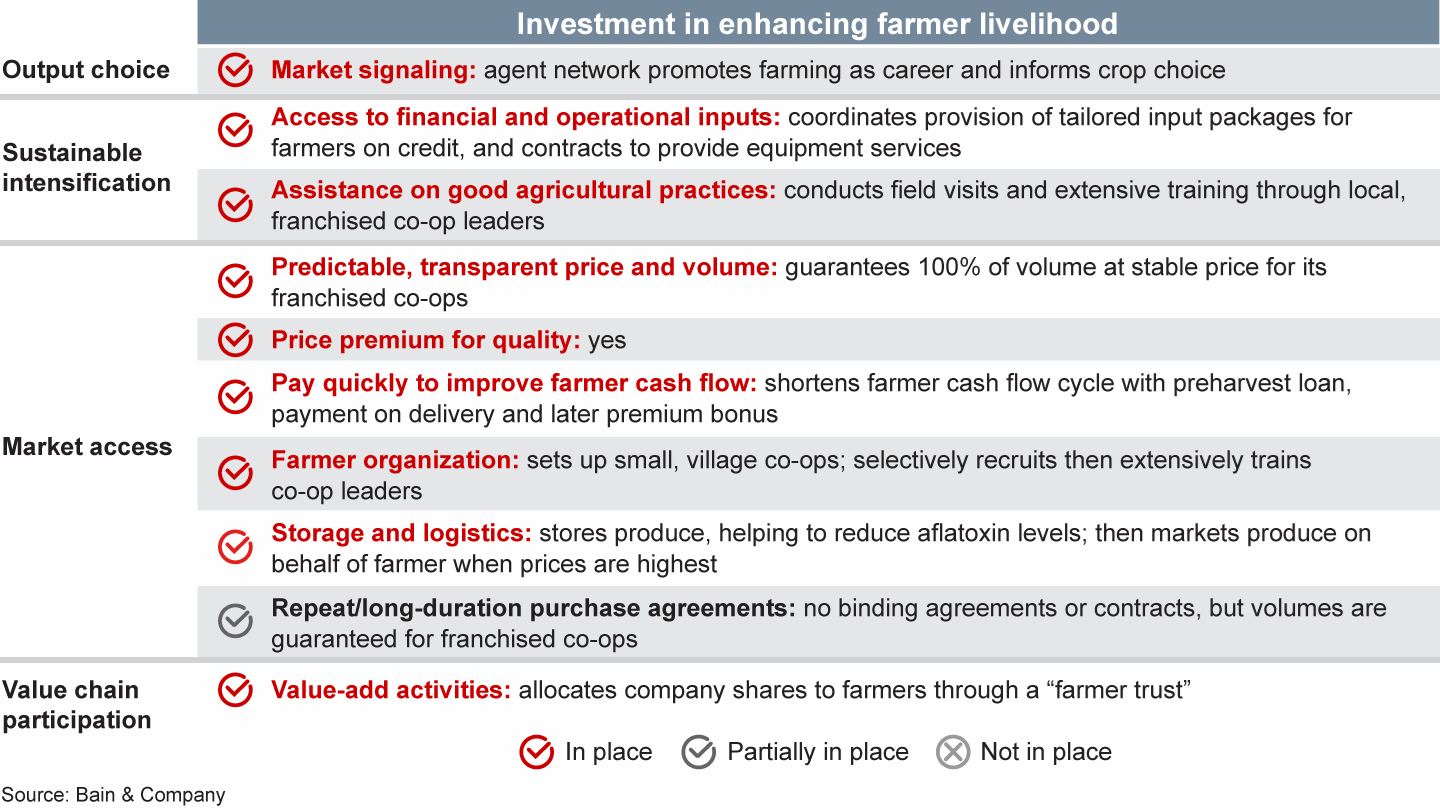
Babban Gona connects smallholder farmers and local cooperatives to premium buyers

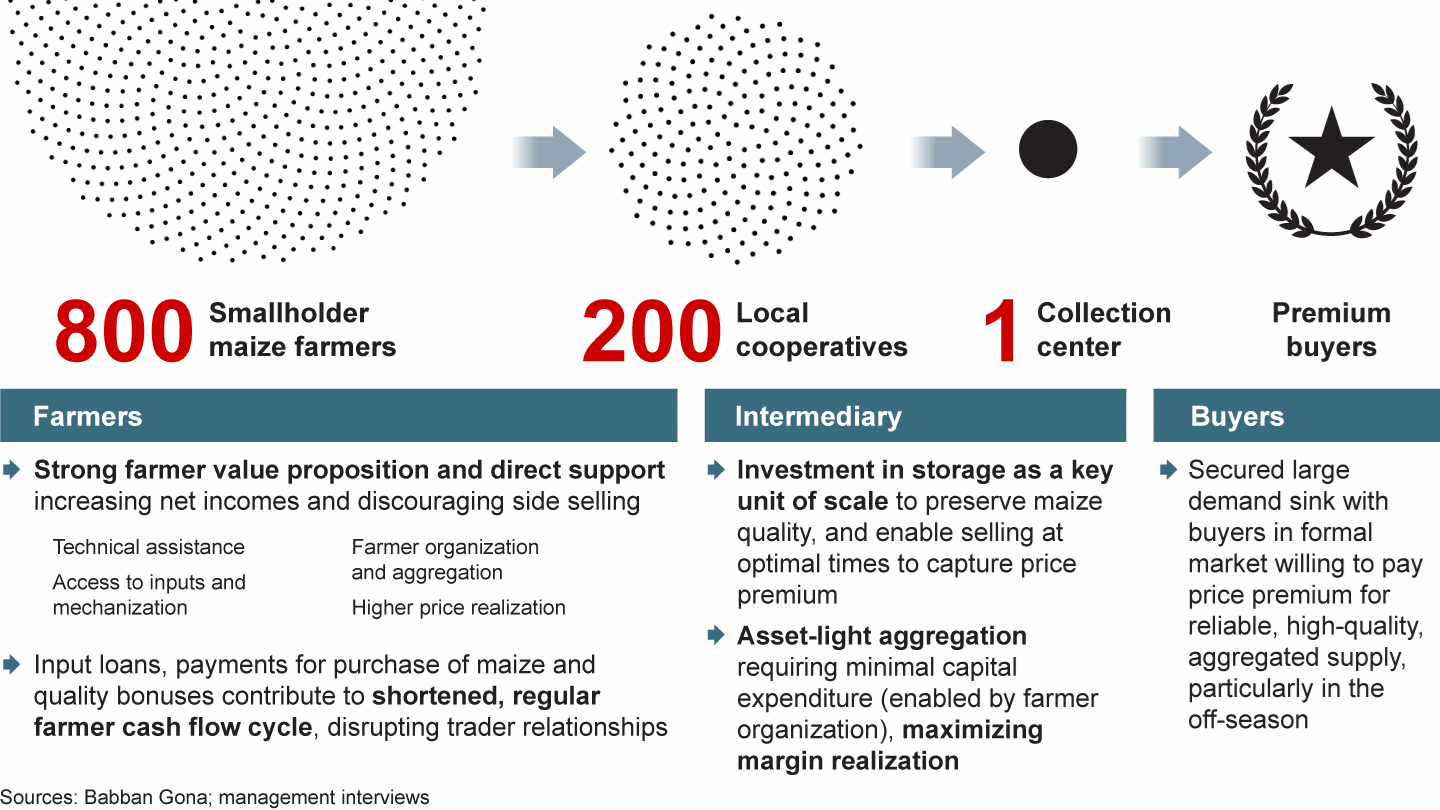
The success of this model enabled Babban Gona to reach more than $20 million in revenue in just over six years. Its unique model caught the attention of early donors who provided grants that supported farmer organization and the validation of the new aggregation and storage models. Once validated, major debt and equity investments supported loans to smallholder farmers for the purchase of seeds and other inputs, an expansion of the number of collection centers, and efforts to reach more farmers.
Other cereal-focused farmer-allied intermediary models
Similar to Babban Gona, other intermediaries have also found success by building on large, secured demand from a premium buyer; engaging with farmers to build their loyalty and improve productivity and crop quality; innovating to reduce post-harvest loss and improve quality; increasing efficiency; and integrating vertically (see Figure 9).
Despite structural challenges, there are successful farmer-allied business models in staple crops

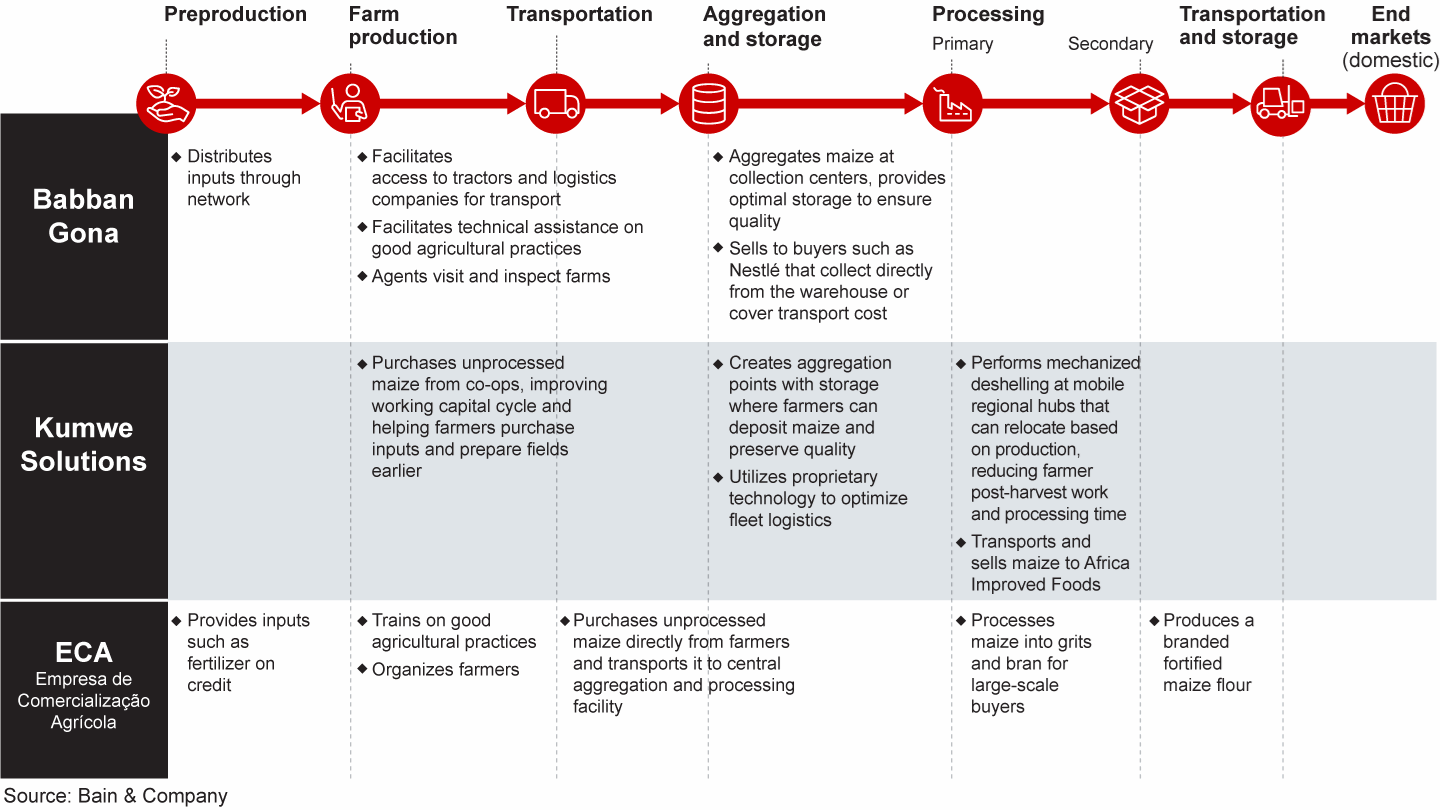
In Rwanda, Kumwe Solutions’ revenue has reached nearly $3 million in just three years by following these steps. It offers innovative harvest services to farmers, including large-scale mechanized mobile deshelling and drying equipment that local communities can access at processing hubs. Its proprietary technology for optimizing fleet logistics, combined with its network of collection, storage and processing hubs, has greatly improved the efficiency of the supply chain. The time it takes for goods to move from harvest to end buyer has dropped from 67 days traditionally to just 6 days currently.
Moreover, Kumwe’s process has eliminated key maize quality challenges, reducing 90% rejection rates from premium buyers to less than 1%. As a result, Kumwe has quickly become Rwanda’s largest aggregator of local maize. Its maize is sold to Africa Improved Foods, a joint venture between the government of Rwanda and a consortium of private/public entities that supply food to the UN’s World Food Programme, a large, reliable buyer willing to pay a premium for safe, high-quality, locally produced products. Further, Kumwe has built trust with farmers and improved their cash flow by paying within one to three days of harvest. With their maize improving and time to market shrinking, farmers have enjoyed better incomes, which, in turn, reduce side selling and encourage investment in future maize production.
A second company, Empresa de Comercialização Agrícola (ECA), follows these same principles, operating as both a processor and as a profitable vertically integrated brand in the Catandica region near the western border of Mozambique. It also sells to well-established buyers—namely, major breweries and feed producers. ECA processes maize into grits and bran for these large corporate buyers and into a branded fortified maize flour of its own, Bella Xima, for local consumers. Excise tax concessions from the government designed to encourage sourcing from Mozambique’s smallholder farmer base motivate major breweries and feed producers to buy from ECA. ECA advises farmers on crop choice and provides them with tailored packages of inputs on credit. It transports maize and processes it as well, and its integrated model is working. Revenue has more than doubled over the past five years, to more than $3 million in 2018.
Key insights:
- Securing a large, reliable buyer for staple crops ensures stability and sustainability of operations.
- Having buyers that pay a price premium for higher quality ensures that there is margin available for intermediaries to invest in ongoing engagement with smallholder farmers.
- Business model innovations in aggregation that are clearly compelling to farmers are critical to disrupting traditional sales channels and securing quality and quantity of supply.
- Innovations that shorten cash flow cycles for farmers build farmer loyalty, enabling more farm investment and reducing side selling.
- Innovations that enhance crop quality are key to buyers paying a premium for safe ingredients and may encourage them to source more locally.
- A low-margin value chain requires scale and ruthless efficiency.
- In addition to price increases from large buyers willing to pay a premium for quality, cost reduction from operational efficiencies and high return on investment technologies improve margins.
- Diversification into processing can provide an additional profit stream and may be necessary to target other end markets, such as beer and animal feed, in order to generate margins that improve smallholder farmer livelihoods.
- More philanthropic and impact-oriented patient capital is often required to support necessary farmer-level interventions, especially in earlier stages.
- Grants are critical for farmer aggregation through co-op organization and other means as well as for training in good agricultural practices.
- It may be difficult to achieve high returns given the structurally small margins of these value chains, but the food security benefits are significant. Government subsidies may be well placed here given this important social benefit.